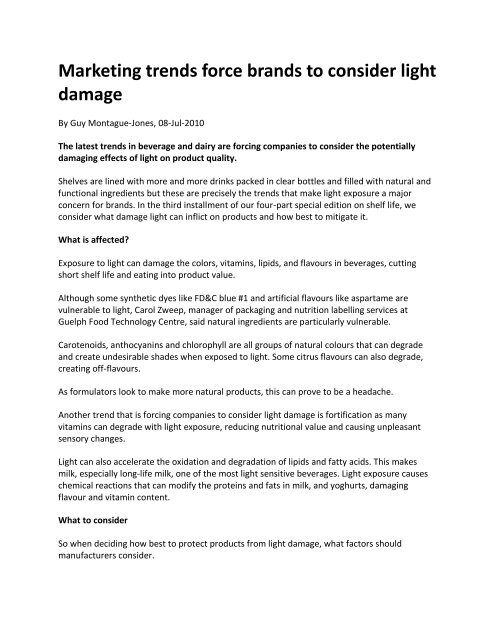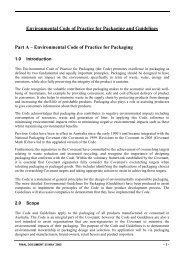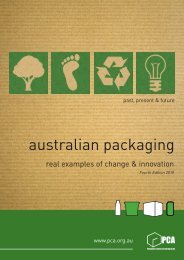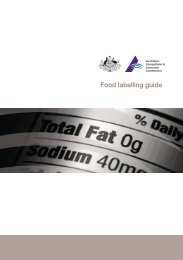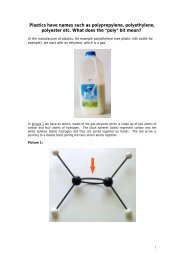Marketing trends force brands to consider light damage
Marketing trends force brands to consider light damage
Marketing trends force brands to consider light damage
You also want an ePaper? Increase the reach of your titles
YUMPU automatically turns print PDFs into web optimized ePapers that Google loves.
<strong>Marketing</strong> <strong>trends</strong> <strong>force</strong> <strong>brands</strong> <strong>to</strong> <strong>consider</strong> <strong>light</strong><strong>damage</strong>By Guy Montague-Jones, 08-Jul-2010The latest <strong>trends</strong> in beverage and dairy are forcing companies <strong>to</strong> <strong>consider</strong> the potentiallydamaging effects of <strong>light</strong> on product quality.Shelves are lined with more and more drinks packed in clear bottles and filled with natural andfunctional ingredients but these are precisely the <strong>trends</strong> that make <strong>light</strong> exposure a majorconcern for <strong>brands</strong>. In the third installment of our four-part special edition on shelf life, we<strong>consider</strong> what <strong>damage</strong> <strong>light</strong> can inflict on products and how best <strong>to</strong> mitigate it.What is affected?Exposure <strong>to</strong> <strong>light</strong> can <strong>damage</strong> the colors, vitamins, lipids, and flavours in beverages, cuttingshort shelf life and eating in<strong>to</strong> product value.Although some synthetic dyes like FD&C blue #1 and artificial flavours like aspartame arevulnerable <strong>to</strong> <strong>light</strong>, Carol Zweep, manager of packaging and nutrition labelling services atGuelph Food Technology Centre, said natural ingredients are particularly vulnerable.Carotenoids, anthocyanins and chlorophyll are all groups of natural colours that can degradeand create undesirable shades when exposed <strong>to</strong> <strong>light</strong>. Some citrus flavours can also degrade,creating off-flavours.As formula<strong>to</strong>rs look <strong>to</strong> make more natural products, this can prove <strong>to</strong> be a headache.Another trend that is forcing companies <strong>to</strong> <strong>consider</strong> <strong>light</strong> <strong>damage</strong> is fortification as manyvitamins can degrade with <strong>light</strong> exposure, reducing nutritional value and causing unpleasantsensory changes.Light can also accelerate the oxidation and degradation of lipids and fatty acids. This makesmilk, especially long-life milk, one of the most <strong>light</strong> sensitive beverages. Light exposure causeschemical reactions that can modify the proteins and fats in milk, and yoghurts, damagingflavour and vitamin content.What <strong>to</strong> <strong>consider</strong>So when deciding how best <strong>to</strong> protect products from <strong>light</strong> <strong>damage</strong>, what fac<strong>to</strong>rs shouldmanufacturers <strong>consider</strong>.
Zweep said it is important <strong>to</strong> think about the nature of the <strong>light</strong> that products are exposed <strong>to</strong>.She said a lot of <strong>brands</strong> focus on UV <strong>light</strong> when products spend much of their life beforereaching the cus<strong>to</strong>mer under flurescent <strong>light</strong>ing. It can therefore be important <strong>to</strong> <strong>consider</strong> howexposure <strong>to</strong> visible <strong>light</strong> will affect product quality.But before even thinking about the nature of the <strong>light</strong> hitting product packaging, it is important<strong>to</strong> <strong>consider</strong> the nature of the product itself.Morag Girdwood, global brand development manager, at ColorMatrix said beverage <strong>brands</strong>promoting the high vitamin content of their products should pay close attention <strong>to</strong> the impac<strong>to</strong>f <strong>light</strong>. This is not only because <strong>light</strong> can affect the vitamin content but because of theconsequences for taste if <strong>light</strong> is allowed <strong>to</strong> degrade the vitamins.Another important <strong>consider</strong>ation is the shelf life that companies are looking <strong>to</strong> achieve. If theywant <strong>to</strong> sell a product with an extra long shelf, such as a long-life milk, then more protectionwill be needed.For a milk product, Girdwood warned that there is some compromise between length of shelflife and the ‘whiteness’ of the bottle that is achievable.Another potential aesthetic compromise relates <strong>to</strong> bottle transparency. Beverage <strong>brands</strong> want<strong>to</strong> show off the content of their products but Zweep from Guelph Food Technology Centre saidthis makes it difficult <strong>to</strong> protect products from <strong>light</strong>.Girdwood claimed that ColorMatrix has developed a solution <strong>to</strong> this problem with the creationof a <strong>light</strong> protection technology that is added <strong>to</strong> the colour rather than the resin of the bottle.There are in fact a range of options open <strong>to</strong> <strong>brands</strong> looking for <strong>light</strong> protection, with thedecision as <strong>to</strong> which one <strong>to</strong> go for dependent on their mix of priorities. Options include theaddition of a white colorant or a UV additive, and the use of a multilayer bottle or a full bodyshrink sleeve.To help companies decide which option <strong>to</strong> go for, testing services are available. Niama Boutroy,a spokesperson from Sidel, which runs a packaging testing service in France for sensitivebeverages, said they map out different options and see how they perform against the desiredshelf life in the expected environmental conditions, on a worst case scenario basis.As for the next steps in <strong>light</strong> protection, Girdwood from ColorMatrix said the company isworking on combining different technologies and meeting sustainability requirements. Thiscould mean combining oxygen and <strong>light</strong> protection while allowing manufacturers <strong>to</strong> continuereducing the weight of their bottles.


